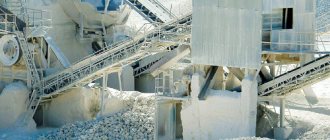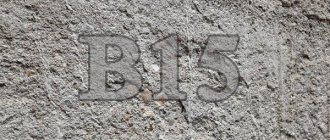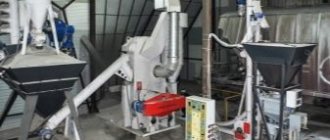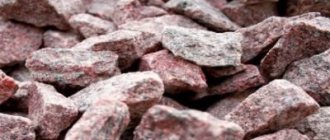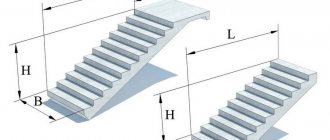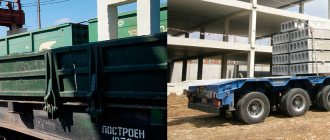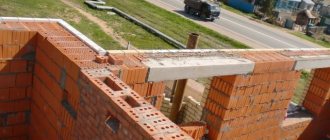Ordinary cement can undergo changes and break down when the temperature rises. Since this material is most often used in construction, there is a need to look for fire-resistant modifications.
In many situations, it is necessary to use refractory cement, which can withstand continuous thermal loads of up to 3000 ℃ without breaking. Particular fire resistance is due to the composition and production technology. The material is intended for use in residential and industrial construction; refractory cements are used in the construction of furnaces, where they exhibit good qualities when the mixture is properly prepared.
What is aluminous cement called?
One of the most important building materials in conditions of high humidity is alumina cement.
Rapidly hardening in air and water, this substance with high strength properties is indispensable in construction as a component of high-temperature and waterproofing mortars and concretes.
The common name “alumina Portland cement” is not correct, since alumina cement and Portland cement are different materials.
There are two types of aluminate cement in demand in industry - alumina cement (HA) (35% Al2O3) and high alumina cement (HAC) (60-80% Al2O3).
Differences between aluminous and Portland cement
Although aluminate mixture and Portland cement have a common purpose, due to the difference in mineral composition, the properties of the materials differ significantly.
A short list of differences:
- the strength gain of the GC proceeds as an exothermic reaction, which can take up to a day;
- the density of the GC monolith significantly exceeds that of Portland cement;
- the water resistance of the GC monolith is an order of magnitude higher than that of classical cement;
- GCs reach their design strength after three days, Portland cement reaches the same strength indicator after twenty-eight days;
- a monolith made of aluminate cement is more susceptible to the destructive effects of an alkaline environment than standard material.
Portland cement concretes in a humid environment quickly lose their qualities - penetrating into the pores, moisture causes corrosion of the reinforcement, and soluble salts destroy the structure of the monolith.
Aluminous compositions do not have these disadvantages.
The production of aluminate material is less than 1% of the total volume of cement produced. The reason is the shortage of raw materials and the high cost of GC.
Brands of refractory cements
Heat-resistant types of cement are made with the addition of alumina, strictly in accordance with GOST.
The main indicator for their division into brands is the aluminum oxide content. The abbreviation GC denotes products with an aluminum oxide concentration of at least 35%.
Brands with a higher mass fraction of oxide are designated by the letter combination VGC.
VHC I products contain the following concentrations of oxides: minimum 60% aluminum; calcium – 32%; silicon – 3%; iron, magnesium, sulfur – from 1% to 2%.
VGC II products contain at least 70% aluminum oxide, slightly less calcium and silicon oxides than the previous brand, and the same amount of the rest.
In VGC III cement, aluminum oxide is at least 80%, calcium and silicon oxides are 18% and 0.5%, respectively, and the rest is the same amount.
All brands of products labeled VHC contain trace amounts of titanium oxide.
In the marking next to the beeches, numbers are indicated that indicate the tensile strength under compressive loads on the product after 3 days of aging. For example, GC 40 cement can withstand a load of at least 40 MPa.
Table. Technical parameters of refractory cements
| Indicator name | Value for cement type and grade | ||||||
| GC | VGC I | VGC II | VGC III | ||||
| 40 | 50 | 60 | 35 | 25 | 35 | 25 | |
| 1. Compressive strength, MPa, not less, at age: | |||||||
| 1 day | 22,5 | 27,4 | 32,4 | — | — | — | — |
| 3 days | 40,0 | 50,0 | 60,0 | 35,0 | 25,0 | 35,0 | 25,0 |
| 2. Grinding fineness: | |||||||
| residue on sieve with mesh No. 008 according to GOST 6613, %, no more | 10 | 10 | 10 | 10 | 10 | 10 | 10 |
| specific surface, m2/kg, not less | — | — | — | 300 | 300 | 300 | 300 |
| 3. Setting time: | |||||||
| start, min, not earlier | 45 | 45 | 45 | 30 | 30 | 30 | 30 |
| end, no later than | 10 | 10 | 10 | 12 | 15 | 15 | 15 |
| 4. Fire resistance, °C, not less | — | — | — | 1580 | 1670 | 1670 | 1670 |
Buyers choose a brand taking into account the actual thermal and mechanical loads under which the cement will be used. The building materials market offers brands of reputable domestic manufacturers of refractory materials that use aluminous clinker from the central, Volga regions of the country and Siberia. There are good fireproof mixtures on sale from foreign manufacturers: Poland, France, Turkey, Finland. Imported material is fully packaged; domestic products can be packaged at the request of customers.
Manufacturing technology
Limestones CaCO3 and bauxites with the general formula Al2O3*nH2O are used as raw materials for the production of GC.
Bauxite is heterogeneous in its composition and contains oxides of aluminum (Al2O3), silicon (SiO2), iron (Fe2O3) and others.
In the production of GC, bauxite is used with a silicon modulus (quality factor), which is calculated as the Al2O3/SiO2% ratio and is at least 2%.
Due to the shortage of bauxite in Russia, bauxite iron ore is used, to which limestone and scrap iron are added. Granulated blast furnace slags are used as clinkers.
The use of these materials as raw materials can significantly reduce the cost of aluminate compositions.
There are two main methods for producing high alumina cement.
- Melting at t-1400° C
At a temperature in special drums, the mixture is melted. Allow the resulting product to cool and grind to a fine powder.
- Sintering at t-1300° C
The raw materials are ground to powder and fired in ovens. After the resulting granules have cooled, they are ground into a fine powder.
Attention! The product obtained by melting is an order of magnitude superior in quality to the GC obtained by sintering.
Russian manufacturers of aluminate mixtures mainly produce GC by melting.
Why should you buy VGC cement from PKF PROMSTROYKOMPLEKT?
A number of factors enable the enterprise to ensure the optimal price-quality ratio of the proposed high-alumina cement. Direct partnerships with well-established manufacturers of refractory materials, competent logistics and a policy of reducing support costs are aimed at achieving this goal. Convincing evidence of the excellent parameters of the VHC 1 offered in section is the hygienic, radioactive and quality certificate. These products are supplied in containers or 50 kg bags. The company provides fast delivery of VGC 1-35 cement throughout Moscow, the Moscow region and throughout Russia.
By purchasing fire-resistant and heat-insulating building materials from us, the client receives service at the highest level. Main features of the company's service:
- polite and helpful attitude of the staff;
- streamlined algorithm for working with clients;
- responsible attitude towards one's obligations;
- a clear understanding of the buyer’s interests;
- provision of related services (consulting on the choice of building materials, delivery, etc.).
You can purchase high-alumina cement grade VGTs 1 (GOST 969-91) by contacting the sales department of PKF PROMSTROYKOMPLEKT. For this purpose, it is enough to make an online application on the appropriate page of the resource or call a toll-free phone number.
Our specialists are always ready to advise you on our products. +7 Free call throughout Russia
Properties, advantages and disadvantages
Aluminous cements are a dark, finely dispersed powder, which in air and aqueous environments, when mixed with water, forms binders that harden in a short time.
Compositions based on them have a number of unique qualities:
- high setting speed and rapid development of design strength;
- the ability to work with solutions at low temperatures;
- the ability to form a high-strength monolith with fire-resistant properties;
- indifferent attitude towards aggressive environments (except alkaline ones).
Product advantages:
- in terms of setting speed and time of strength development, it is an order of magnitude superior to the best indicators of Portland cement;
- increased frost resistance;
- lack of corrosion and insensitivity to aggressive environments;
- high fire resistance values of products;
- excellent protection of the reinforcing mesh of concrete products from external influences;
- High-alumina and expanding types of GC are used in works of high complexity that cannot be performed with other materials.
Disadvantages of the product:
- high cost of GC associated with the peculiarities of production;
- cannot be used for filling large areas - due to the release of thermal energy during strength development, setting is uneven, which leads to destruction;
- due to heat generation, the product cannot be used at temperatures above 30° C;
- are destroyed by alkaline media.
Note! The quality of the aluminous material directly depends on the degree of dispersion - the finer the grind, the better the setting and the higher the strength characteristics.
Compound
All cements are mineral compositions based on limestone, clay and gypsum.
You may get the impression that such raw materials obviously have fire-resistant properties. Limestone and gypsum actually withstand heat well, while the heat resistance of clay largely depends on its nature.
There are 5 types of cement mixtures, of which Portland cement with maximum thermal stability of up to 600 ℃ is the most widely used in common practice.
Heating up to 250 ℃ provokes the appearance of the first cracks, through which smoke and fire can spread. At higher temperatures, Portland cement begins to deteriorate, which can lead to serious consequences in case of fires.
Table. Oxide content in high-alumina compounds
| Type of cement | Content of oxides of the following elements, % | ||||||
| Calcium oxide CaO | Iron oxide Fe2O3 | Silicon oxide SiO2 | Magnesium oxide MgO | Sulfur oxide SO3 | Titanium dioxide TiO2 | Aluminum oxide Al2O3 | |
| VGC I | 32% | 1.0% | 3.0% | 1.5% | 2.0% | 0.05% | 60% |
| VGC II | 28% | 1.0% | 1.5% | 1.0% | 2.0% | 0.05% | 70% |
Refractory cement, made on the basis of special types of clay with a predominance of aluminous and high-alumina raw materials, safely withstands fairly long heating up to 1480 ℃, special types - up to 1750 ℃. The increased heat resistance is due to high concentrations of aluminum oxide, which range from 55% to a maximum of 70%.
Application of aluminous materials
Although GC has a number of advantages over traditional cement, it has not found widespread use. The reason for the limited scope of use of the product is the high price - it is 3-5 times more expensive than standard cement.
Therefore, aluminous mixtures are used only where the use of a more expensive material is justified by its specific properties.
Alumina cement is indispensable when performing the following work:
- during repair work to restore elements of hydraulic structures, including waterproofing treatment facilities;
- as a waterproofing material when plugging oil wells;
- in shipping to eliminate hull holes;
- waterproofing emergency leaks of sewer and water supply networks;
- when repairing shower rooms and swimming pools;
- to obtain a solution that can harden and gain strength in a short time - 1, 2 or 7 days;
- for producing waterproofing plaster;
- during the construction of structures, during the operation of which contact with aggressive environments is required (excluding alkaline ones);
- for anti-corrosion protection of reinforcement mesh;
- in the manufacture of individual products and concrete with fire resistance up to 1700° C.
Due to its properties, GC is used in construction as a component of expanding, fire-resistant, rapid-hardening, prestressing and other special compositions.
Due to their fire resistance, aluminate compositions are widely used in metallurgy as a component of heat-resistant dry mixtures and concrete.
ACCEPTANCE
Cements are accepted according to GOST 30515 with the following additions:
1) the volume of a batch of high-alumina cement should not exceed 75 tons for plants with an annual cement production of up to 5.0 thousand tons and the capacity of one silo (but not more than 200 tons) for plants with an annual cement production of more than 500 tons. 5.0 thousand tons;
2) a batch of cement is accepted and can be shipped if the results of acceptance tests for strength, fineness of grinding, setting time and chemical composition meet the requirements of this standard;
3) the fire resistance of high-alumina cements is determined for at least 20% of cement batches.
Main characteristics
The properties of alumina cement differ from those of ordinary Portland cement:
- High hardening speed - in the first day, the strength gain of concrete reaches 50% of the brand three-day indicator. Moreover, during the first 24 hours an intense exothermic reaction occurs, which is beneficial in winter and allows you to maintain the optimal temperature for hydration for a long time.
- Concretes based on alumina cement are heat-resistant, suitable for laying furnaces and industrial structures, structures exposed to intense heating. By adding special mineral components, a fire-resistant stone of hydraulic hardening is obtained.
- Cement forms a stone of increased strength, density and water resistance, while it has little resistance to alkalis and is destroyed under their influence.
Subtleties of production
The characteristics of individual types of cement are determined by the presence of mineral components in the powder, the amount of which for each type of binder is strictly regulated by standards. Chemical elements are added to natural raw materials artificially or compensated for by rocks deficient in these components.
Cement is made in different ways depending on the ingredients used:
- Melting. Coke and limestone are added to bauxite and heated to melting point in water-cooled water jacket furnaces. Heated air is supplied to the chamber, under the influence of which the raw material changes its structure and is fired. It is then passed through a tap hole and cooled in the molds of the furnace. The cooled billet is sent to a crusher with multi-chamber mills. Less commonly used is the arc melting method, which requires an alternating current furnace. This method is more expensive, but the cement is of high quality.
- Sintering occurs in conventional factory furnaces at lower temperatures compared to melting. The raw material heats up for a long time, then cools sharply. This is necessary to maintain the structure of the cement and prevent it from crystallizing and turning into glass.
Buy high-alumina white cement SRB 710 (Secar 71)
You can buy the high-alumina white cement SRB 710 (Secar 71) offered in the Legobeton online store not only in a bag (25 kg) but also packaged in a convenient plastic container (1-10 kg) in which its characteristics are preserved for a long time. Plastic packaging prevents damage during transportation and protects against moisture.
If you do not need to prepare a large volume of mixture for your work, then buying packaged refractory aluminous white cement will be the right decision both from the point of view of saving money and from the point of view of transportation.
It must be taken into account that any cement ages and should not be taken “in reserve”. After a year, unused cement may lose its strength properties. That is why it is worth buying exactly the amount of white aluminous cement that you need for the current job.
TRANSPORTATION AND STORAGE
Transportation and storage of cements is carried out in accordance with GOST 22237 with the following additions:
1) shipment of high-alumina cements is carried out only in packaged form;
2) shipment of aluminous cements without packaging in specialized transport is carried out by agreement between the manufacturer and the consumer;
3) it is allowed to ship cements without packaging in soft containers according to regulatory and technical documentation approved in the prescribed manner.
